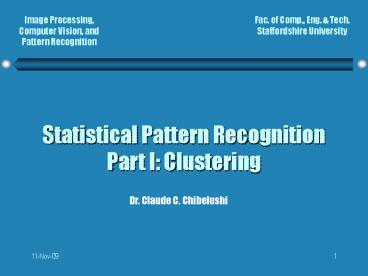Statistical Pattern Recognition Part I: Clustering - PowerPoint PPT Presentation
1 / 19
Title:
Statistical Pattern Recognition Part I: Clustering
Description:
connectionist pattern recognition is sometimes considered as subset of ... p = 1 gives city-block distance (a.k.a. Manhattan distance or taxi-cab distance) ... – PowerPoint PPT presentation
Number of Views:50
Avg rating:3.0/5.0
Title: Statistical Pattern Recognition Part I: Clustering
1
Image Processing, Computer Vision, and Pattern
Recognition
Fac. of Comp., Eng. Tech. Staffordshire
University
Statistical Pattern RecognitionPart I
Clustering
Dr. Claude C. Chibelushi
2
Outline
- Introduction
- Features
- Clustering
- k-means clustering algorithm
- Pattern Similarity
- Summary
3
Introduction
- Examples of pattern recognition tasks
Image scene
- scene object (car, road, ...)
- alphabet letter (a, b, c, ...)
- writers name
Handwriting
- word (one, two, three, ...)
- speakers name
Speech
4
Introduction
- Pattern recognition
- Categorisation of patterns into a finite number
of classes - Common approaches
- statistical pattern recognition
- connectionist pattern recognition is sometimes
considered as subset of statistical recognition - syntactic pattern recognition
5
Introduction
- Pattern recognition
- Statistical
- classification based on statistical distribution
of patterns - Syntactic
- classification based on structural relationship
between elements of pattern - Connectionist
- classification using artificial neural networks
(statistical basis?)
6
Introduction
- Terminology
- Feature(s) representation or description of
salient pattern attribute(s) - Class category , group, type
- patterns with common characteristics/properties
- Classification assignment of class label to
observed pattern
7
Features
- Patterns often considered as points in space
- selected pattern attributes or properties
(features) represented by - numerical measurements
- linguistic labels
- space often multidimensional, hence
- set of numerical property values called feature
vector
8
Features
- Examples attributes for
- pixel-based image segmentation
- pixel colour, edge strength,
- object recognition
- object shape, colour, size,
9
Features
- Example 2D feature plot for two image types (5
samples of each)
10
Clustering
- Clustering unsupervised learning that identifies
groups of similar data samples - partial supervision (labelling of some samples)
is possible - Cluster group of similar data samples, which are
dissimilar from samples in other groups - for pattern recognition sample is synonymous
with pattern
11
Clustering
- Example applications
- Image processing image segmentation into
homogeneous regions - data samples image pixels
- sample details pixel colour, edge strength, edge
direction, - Marketing market segmentation into groups of
customers with similar buying behaviour - data samples customers
- sample details database of purchases,
demographics, - Insurance profile identification of low- or
high-risk clients - data samples clients
- sample details database of client claim history,
demographics,
12
Clustering
- k-means clustering algorithm
- Iterative algorithm for finding k clusters
- number of clusters assumed known
- Each cluster represented by prototype
- cluster centroid (mean)
13
Clustering
- k-means clustering algorithm pseudo code
- kMeansClustering(dataSamples, k)
- initialise cluster centroids
- do
- // assign each sample to a cluster
- for each data sample
- find nearest cluster centroid
- // update each cluster mean
- for each cluster
- update centroid
- until (centroids change is insignificant)
14
Clustering
- k-means clustering algorithm
- Limitations
- requires prior knowledge of number of clusters
- may fail to find optimal grouping of samples
- sensitive to choice of
- initial cluster prototypes
- e.g. what if a prototype is far from any data
sample? - distance measure (similarity measure)
15
Clustering
- k-means clustering algorithm
- As result of limitations, experimentation is
often required - multiple trials with different
- k
- initial prototype values
- distance measures
16
Pattern similarity
- Similarity often tied to geometrical distance
between points that represent samples - Many similarity measures are available
- choice is application dependent
17
Pattern similarity
- Minkowski metric
- popular similarity measure
- family of distance measurements between two
points - v point (represents feature vector)
- vk coordinate of point (i.e. feature)
- m dimensionality of data space (i.e. number of
features)
18
Pattern similarity
- Minkowski metric (ctd.)
- special cases
- p 1 gives city-block distance (a.k.a. Manhattan
distance or taxi-cab distance) - equivalent to Hamming distance if observation
vectors are binary - p 2 gives Euclidean distance
19
Pattern similarity
- Minkowski metric pseudo code
- sum 0
- for feature from 1 to m
- diff featVector1feature featVector2feature
- pDiff power( abs(diff), p )
- sum sum pDiff
- sum power( sum, 1 / p )
20
Pattern similarity
- Minkowski metric (ctd.)
- limitations
- sensitive to non-uniform scale across features
- large-scale features may dominate distance
calculation - e.g. when features have different measurement
units - sensitive to correlation between features
- see limitations of minimum-distance classifier
(in Part II)
21
Summary
- Clustering unsupervised identification groups of
similar data samples - Features salient pattern attributes
- k-means clustering algorithm
- iterative algorithm for finding k clusters
- each represented by prototype
- experimentation is often required as result of
algorithm limitations - Geometrical distance often used as similarity
measure - e.g. Minkowski metric































